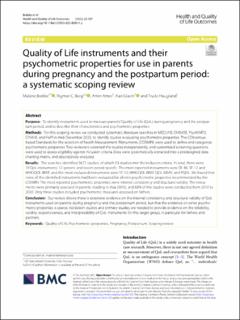| dc.contributor.author | Brekke, Malene | |
| dc.contributor.author | Berg, Rigmor | |
| dc.contributor.author | Amro, Amin Abdul-Galeel | |
| dc.contributor.author | Glavin, Kari | |
| dc.contributor.author | Haugland, Trude | |
| dc.date.accessioned | 2022-08-15T11:38:55Z | |
| dc.date.available | 2022-08-15T11:38:55Z | |
| dc.date.created | 2022-07-13T22:52:57Z | |
| dc.date.issued | 2022 | |
| dc.identifier.citation | Health and Quality of Life Outcomes. 2022, 20, Article number: 107, 1-19 | en_US |
| dc.identifier.issn | 1477-7525 | |
| dc.identifier.uri | https://hdl.handle.net/11250/3011864 | |
| dc.description | This article is licensed under a Creative Commons Attribution 4.0 International License, which permits use, sharing, adaptation, distribution and reproduction in any medium or format, as long as you give appropriate credit to the original author(s) and the source, provide a link to the Creative Commons licence, and indicate if changes were made. The images or other third party material in this article are included in the article’s Creative Commons licence, unless indicated otherwise in a credit line to the material. If material is not included in the article’s Creative Commons licence and your intended use is not permitted by statutory regulation or exceeds the permitted use, you will need to obtain permission directly from the copyright holder. To view a copy of this licence, visit http://creativecommons.org/licenses/by/4.0/. The Creative Commons Public Domain Dedication waiver (http://creativeco mmons.org/publicdomain/zero/1.0/) applies to the data made available in this article, unless otherwise stated in a credit line to the data. | en_US |
| dc.description.abstract | Purpose: To identify instruments used to measure parents’ Quality of Life (QoL) during pregnancy and the postpartum period, and to describe their characteristics and psychometric properties.
Methods: For this scoping review we conducted systematic literature searches in MEDLINE, EMBASE, PsychINFO, CINAHL and HaPI in mid-December 2020, to identify studies evaluating psychometric properties. The COnsensusbased Standards for the selection of health Measurement INstruments (COSMIN) were used to defne and categorize psychometric properties. Two reviewers screened the studies independently, and customized screening questions were used to assess eligibility against inclusion criteria. Data were systematically extracted into a predesigned data charting matrix, and descriptively analyzed.
Results: The searches identifed 5671 studies, of which 53 studies met the inclusion criteria. In total, there were 19 QoL instruments: 12 generic and seven period specifc. The most reported instruments were SF-36, SF-12 and WHOQOL-BREF, and the most evaluated instruments were SF-12, WHOQOL-BREF, QOL-GRAV, and PQOL. We found that none of the identifed instruments had been evaluated for all nine psychometric properties recommended by the COSMIN. The most reported psychometric properties were internal consistency and structural validity. The instruments were primarily assessed in parents residing in Asia (50%), and 83% of the studies were conducted from 2010 to 2020. Only three studies included psychometric measures assessed on fathers.
Conclusion: Our review shows there is extensive evidence on the internal consistency and structural validity of QoL instruments used on parents during pregnancy and the postpartum period, but that the evidence on other psychometric properties is sparse. Validation studies and primary studies are needed to provide evidence on the reliability, validity, responsiveness, and interpretability of QoL instruments for this target group, in particular for fathers and partners. | en_US |
| dc.language.iso | eng | en_US |
| dc.publisher | BioMed Central | en_US |
| dc.rights | Navngivelse 4.0 Internasjonal | * |
| dc.rights.uri | http://creativecommons.org/licenses/by/4.0/deed.no | * |
| dc.subject | Psykometri | en_US |
| dc.subject | Psychometrics | en_US |
| dc.subject | Livskvalitet | en_US |
| dc.subject | Quality of Life | en_US |
| dc.subject | Scoping review | en_US |
| dc.subject | Etter fødsel | en_US |
| dc.subject | Postnatal | en_US |
| dc.subject | Graviditet | en_US |
| dc.subject | Pregnancy | en_US |
| dc.subject | postpartum | en_US |
| dc.subject | psychometric properties | en_US |
| dc.title | Quality of Life instruments and their psychometric properties for use in parents during pregnancy and the postpartum period: a systematic scoping review | en_US |
| dc.type | Peer reviewed | en_US |
| dc.type | Journal article | en_US |
| dc.description.version | publishedVersion | en_US |
| dc.rights.holder | © The Author(s) 2022. | en_US |
| dc.source.pagenumber | 1-19 | en_US |
| dc.source.volume | 20 | en_US |
| dc.source.journal | Health and Quality of Life Outcomes | en_US |
| dc.identifier.doi | 10.1186/s12955-022-02011-y | |
| dc.identifier.cristin | 2038289 | |
| dc.source.articlenumber | 107 | en_US |
| cristin.ispublished | true | |
| cristin.fulltext | original | |
| cristin.qualitycode | 1 | |

